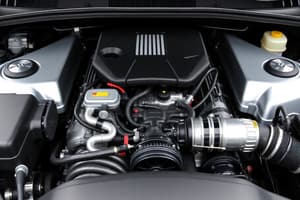Podcast
Questions and Answers
ऑटोमोबाइल का दूसरा नाम क्या है?
ऑटोमोबाइल का दूसरा नाम क्या है?
- कार (correct)
- ट्रेन
- साइकिल
- बस
आमतौर पर ऑटोमोबाइल में कितने पहिये होते हैं?
आमतौर पर ऑटोमोबाइल में कितने पहिये होते हैं?
- तीन
- दो
- चार (correct)
- पांच
ऑटोमोबाइल का मुख्य कार्य क्या है?
ऑटोमोबाइल का मुख्य कार्य क्या है?
- लोगों और सामानों का परिवहन करना (correct)
- खाना बनाना
- कपड़े धोना
- संगीत बजाना
पहला गैसोलीन-संचालित ऑटोमोबाइल का आविष्कार किसने किया?
पहला गैसोलीन-संचालित ऑटोमोबाइल का आविष्कार किसने किया?
असेंबली लाइन की शुरुआत करके ऑटोमोबाइल उत्पादन में क्रांति किसने लाई?
असेंबली लाइन की शुरुआत करके ऑटोमोबाइल उत्पादन में क्रांति किसने लाई?
ऑटोमोबाइल को चलाने के लिए इंजन को शक्ति कौन प्रदान करता है?
ऑटोमोबाइल को चलाने के लिए इंजन को शक्ति कौन प्रदान करता है?
वाहन को धीमा करने या रोकने के लिए ड्राइवर को कौन सा सिस्टम अनुमति देता है?
वाहन को धीमा करने या रोकने के लिए ड्राइवर को कौन सा सिस्टम अनुमति देता है?
कौन सा ऑटोमोबाइल प्रकार आमतौर पर चार दरवाजों और एक अलग ट्रंक के साथ होता है?
कौन सा ऑटोमोबाइल प्रकार आमतौर पर चार दरवाजों और एक अलग ट्रंक के साथ होता है?
दुर्घटना के दौरान यात्रियों को रोकने में मदद करने वाली प्राथमिक सुरक्षा सुविधा क्या है?
दुर्घटना के दौरान यात्रियों को रोकने में मदद करने वाली प्राथमिक सुरक्षा सुविधा क्या है?
कौन सी सुविधा ड्राइवरों को उनकी लेन से अनजाने में बाहर निकलने पर सतर्क करती है?
कौन सी सुविधा ड्राइवरों को उनकी लेन से अनजाने में बाहर निकलने पर सतर्क करती है?
Flashcards
ऑटोमोबाइल क्या है?
ऑटोमोबाइल क्या है?
एक स्वचालित, स्व-चालित वाहन जो भूमि पर परिवहन के लिए उपयोग किया जाता है।
पहली ऑटोमोबाइल किसने बनाई?
पहली ऑटोमोबाइल किसने बनाई?
1885 में कार्ल बेंज ने पहली गैसोलीन-पावर्ड ऑटोमोबाइल का आविष्कार किया।
ऑटोमोबाइल के मुख्य भाग क्या हैं?
ऑटोमोबाइल के मुख्य भाग क्या हैं?
इंजन, ट्रांसमिशन, ब्रेकिंग सिस्टम, स्टीयरिंग सिस्टम, सस्पेंशन सिस्टम, इलेक्ट्रिकल सिस्टम, एग्जॉस्ट सिस्टम।
ऑटोमोबाइल के प्रकार क्या हैं?
ऑटोमोबाइल के प्रकार क्या हैं?
Signup and view all the flashcards
ऑटोमोबाइल में सुरक्षा सुविधाएँ क्या हैं?
ऑटोमोबाइल में सुरक्षा सुविधाएँ क्या हैं?
Signup and view all the flashcards
ऑटोमोबाइल का पर्यावरणीय प्रभाव क्या है?
ऑटोमोबाइल का पर्यावरणीय प्रभाव क्या है?
Signup and view all the flashcards
प्रमुख ऑटोमोबाइल निर्माता कौन हैं?
प्रमुख ऑटोमोबाइल निर्माता कौन हैं?
Signup and view all the flashcards
स्वायत्त वाहन कैसे काम करते हैं?
स्वायत्त वाहन कैसे काम करते हैं?
Signup and view all the flashcards
ऑटोमोटिव उद्योग में भविष्य के रुझान क्या हैं?
ऑटोमोटिव उद्योग में भविष्य के रुझान क्या हैं?
Signup and view all the flashcards
असेंबली लाइन का आविष्कार किसने किया?
असेंबली लाइन का आविष्कार किसने किया?
Signup and view all the flashcards
Study Notes
- An automobile, also known as a car, is a self-propelled vehicle used for transportation on land.
- Automobiles typically have four wheels and an internal combustion engine or electric motor for propulsion.
- The primary function of an automobile is to transport people and cargo from one location to another.
- Automobiles can vary in size, shape, and configuration, depending on their intended use.
History and Development
- The development of the automobile began in the late 19th century with inventors such as Karl Benz and Gottlieb Daimler.
- Karl Benz is credited with inventing the first gasoline-powered automobile in 1885.
- Gottlieb Daimler independently developed his own gasoline-powered automobile around the same time.
- Early automobiles were expensive and primarily considered a luxury item for the wealthy.
- Henry Ford revolutionized automobile production with the introduction of the assembly line in the early 20th century.
- The assembly line made automobiles more affordable and accessible to the general public.
- Throughout the 20th century, automobile technology advanced rapidly with improvements in engine design, safety features, and comfort.
- The automotive industry experienced significant growth and globalization, with manufacturers emerging in various countries.
Components and Systems
- An automobile consists of several key components and systems that work together to provide transportation.
- The engine provides the power to propel the vehicle, typically through the combustion of gasoline or diesel fuel.
- The transmission transfers power from the engine to the wheels, allowing the vehicle to move at different speeds.
- The braking system allows the driver to slow down or stop the vehicle using friction.
- The steering system enables the driver to control the direction of the vehicle.
- The suspension system provides a smooth and comfortable ride by absorbing shocks from the road.
- The electrical system powers various components such as lights, wipers, and infotainment systems.
- The exhaust system removes waste gases from the engine and reduces emissions.
- Modern automobiles often include advanced electronic systems such as engine control units (ECUs), anti-lock braking systems (ABS), and electronic stability control (ESC).
Types of Automobiles
- Automobiles come in various types, each designed for specific purposes and preferences.
- Sedans are a common type of automobile, typically with four doors and a separate trunk.
- Hatchbacks have a rear door that swings upward, providing access to a cargo area.
- Sports utility vehicles (SUVs) are larger vehicles with повышенный ground clearance and повышенный cargo capacity.
- Trucks are designed for hauling cargo and often have an open cargo bed.
- Vans are used for transporting people or cargo and typically have a large interior space.
- Electric vehicles (EVs) are powered by electric motors and batteries, offering zero-emission transportation.
Safety Features
- Automobile safety has improved significantly over the years with the introduction of various safety features.
- Seatbelts are a primary safety feature that helps restrain occupants during a collision.
- Airbags provide дополнительный cushioning during a collision to protect occupants from injury.
- Anti-lock braking systems (ABS) prevent the wheels from locking up during braking, improving steering control.
- Electronic stability control (ESC) helps prevent skidding by selectively applying brakes to individual wheels.
- Blind-spot monitoring systems alert drivers to the presence of vehicles in their blind spots.
- Lane departure warning systems alert drivers when they unintentionally drift out of their lane.
- Adaptive cruise control systems maintain a safe distance from the vehicle ahead and can automatically adjust speed.
Environmental Impact
- Automobiles have a significant impact on the environment, primarily through emissions of greenhouse gases and air pollutants.
- The combustion of fossil fuels in gasoline and diesel engines releases carbon dioxide, a major greenhouse gas that contributes to climate change.
- Automobiles also emit air pollutants such as nitrogen oxides, particulate matter, and volatile organic compounds, which can harm human health and the environment.
- Efforts are underway to reduce the environmental impact of automobiles through improved fuel efficiency, alternative fuels, and electric vehicles.
- Hybrid vehicles combine an internal combustion engine with an electric motor to improve fuel efficiency and reduce emissions. Electric vehicles (EVs) offer zero-emission transportation, relying on electricity from renewable sources to power their batteries.
Automotive Industry
- The automotive industry is a global industry involved in the design, development, manufacturing, and marketing of automobiles.
- Major automobile manufacturers include Toyota, Volkswagen, General Motors, Ford, and Honda, among others.
- The automotive industry is a major employer, providing jobs in manufacturing, engineering, sales, and service.
- The industry is subject to various regulations and standards related to safety, emissions, and fuel economy.
- The automotive industry is undergoing significant transformation with the rise of electric vehicles, autonomous driving technology, and new mobility services.
Autonomous Vehicles
- Autonomous vehicles, also known as self-driving cars, are vehicles capable of driving themselves without human input.
- Autonomous vehicles use sensors such as cameras, radar, and lidar to perceive their surroundings and navigate roads.
- Autonomous vehicles rely on advanced software algorithms to make decisions and control the vehicle's movements.
- Autonomous vehicle technology has the potential to improve safety, reduce traffic congestion, and increase mobility for people who cannot drive themselves.
- Autonomous vehicles are still under development, and regulatory frameworks are being established to govern their operation.
Future Trends
- The automotive industry is expected to undergo significant changes in the coming years, driven by technological advancements and changing consumer preferences.
- Electric vehicles are expected to become increasingly popular, with declining battery costs and expanding charging infrastructure.
- Autonomous driving technology is expected to advance, leading to the introduction of self-driving cars in limited areas.
- Connectivity and data analytics are expected to play a greater role in the automotive industry, enabling new services and features.
- Shared mobility services such as ride-hailing and car-sharing are expected to continue to grow, reducing the need for individual car ownership.
Studying That Suits You
Use AI to generate personalized quizzes and flashcards to suit your learning preferences.




